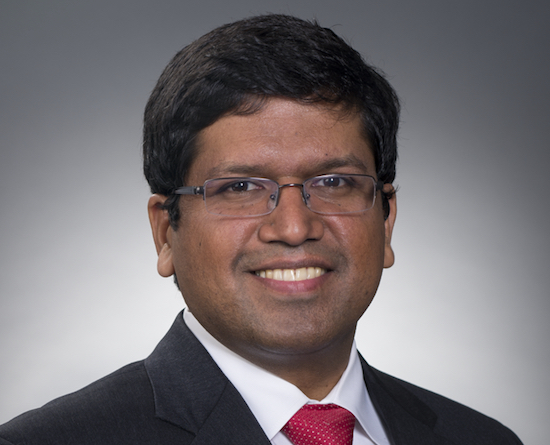A driving force in the 3-D printing world
Rahul Panat is pursuing both of his passions at CMU: research and teaching.
Samantha Jamison
Nov 8, 2017
Rahul Panat, associate professor of mechanical engineering, enjoys the buzzing atmosphere of educational institutions, where students collaborate with faculty and ideas constantly sweep through campus. At Carnegie Mellon, Panat uses advanced aerosol jet technology to study 3-D printing processes at the nano and microscales. But before Panat entered the realm of teaching, he spent 10 years conducting research at Intel—a multi-national tech company—expanding upon the knowledge he acquired as a Ph.D. student in applied mechanics at the University of Illinois, Urbana-Champaign.
As a research and development (R&D) engineer at Intel, Panat focused his work on different areas of microprocessor manufacturing such as high density interconnects and 3-D packaging. He also helped develop the world’s first halogen-free green integrated circuit (IC) chip by eliminating brominated flame retardants from its constituents.
“It was very exciting work because whatever you made or envisioned in the R&D division would actually be produced and sold to millions of people,” says Panat. “Before the development of this chip, lead had already been eliminated from electronic components and packages, so for the first time, IC packages were being produced without any lead or halogens. That was a major accomplishment.”

Source: Mechanical Engineering
Rahul Panat is a new faculty member in the Department of Mechanical Engineering.
Although he was conducting cutting-edge research at Intel, Panat eventually returned to higher education to fulfill his long-term goal of teaching and mentoring students. He began his academic career as an adjunct faculty member at Arizona State University, where he studied the structure of nanomaterials for lithium-ion batteries, before moving to Washington State University, where he focused on nanoparticle 3-D printing.
At WSU, Panat and his colleagues created a revolutionary manufacturing method that produces 3-D structures from the nano-to-centimeter scale. This method uses advanced aerosol jet technology to create fog-like structures by capturing nanoparticles in tiny liquid droplets. Once these structures are made and the droplets are deposited in space, the printer uses heat to evaporate the liquid, leaving only the nanoparticles behind to form complex, strong, and lightweight microstructures. According to Panat, 3-D printing at the nanoscale has applications in many research areas such as lithium-ion batteries.
“Fast-charging/discharging high capacity lithium-ion batteries require porous yet mechanically strong electrodes that can accommodate stresses during the charge-discharge cycles,” he says. “As the strength of a material increases, its density generally increases. It’s thus a challenge to get porous or light materials that are strong. In the past, there was no method to arrange nanoparticles in three-dimensional space and get a controlled porous structure at nano and microscales. Now, we have one.”
My passions were teaching, research, and mentoring students because in a student-centric atmosphere, you can shape somebody’s life for the better. That’s such a powerful concept.
Rahul Panat, Associate Professor, Mechanical Engineering
In 2017, Panat joined Carnegie Mellon’s mechanical engineering department to continue his additive manufacturing research at CMU’s NextManufacturing Center while also mentoring students in the classroom. This semester, in his advanced mechanical design course, Panat teaches his students the fundamentals of mechanical design by making connections to real-world industrial applications.
“I always tell my students what they need to learn in order to be marketable to employers,” says Panat. “When they present their projects in class, I always tell them to present their work as if they are talking to senior managers in a company. Having technical knowledge is important, but getting to know how to communicate that knowledge to different audiences is equally critical.”
As an associate professor of mechanical engineering, Panat is now pursuing both of his passions right here at CMU: research and teaching.
“A lot of times, people think it’s difficult to go back and pursue their dreams after being at one place for so long. But I always tell people to push themselves to get to where they want to be. My passions were teaching, research, and mentoring students because in a student-centric atmosphere, you can shape somebody’s life for the better. That’s such a powerful concept.”
Media Contact:
Lisa Kulick, lkulick@andrew.cmu.edu